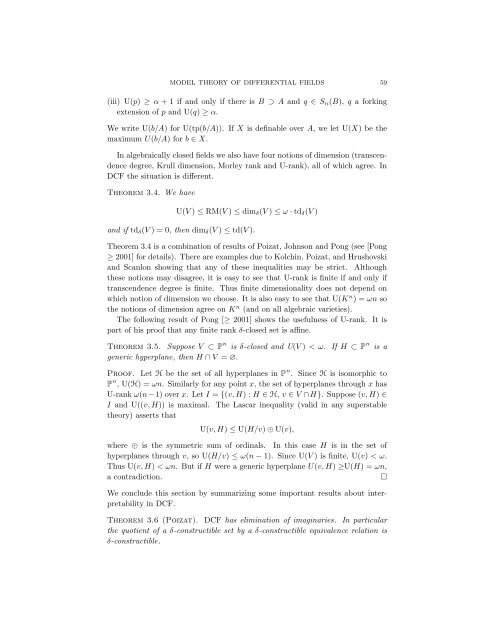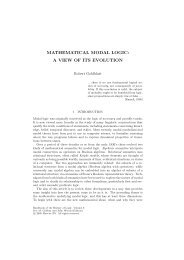Model Theory of Differential Fields
Model Theory of Differential Fields
Model Theory of Differential Fields
You also want an ePaper? Increase the reach of your titles
YUMPU automatically turns print PDFs into web optimized ePapers that Google loves.
MODEL THEORY OF DIFFERENTIAL FIELDS 59(iii) U(p) ≥ α + 1 if and only if there is B ⊃ A and q ∈ S n (B), q a forkingextension <strong>of</strong> p and U(q) ≥ α.We write U(b/A) for U(tp(b/A)). If X is definable over A, we let U(X) be themaximum U(b/A) for b ∈ X.In algebraically closed fields we also have four notions <strong>of</strong> dimension (transcendencedegree, Krull dimension, Morley rank and U-rank), all <strong>of</strong> which agree. InDCF the situation is different.Theorem 3.4. We haveU(V ) ≤ RM(V ) ≤ dim δ (V ) ≤ ω · td δ (V )and if td δ (V ) = 0, then dim δ (V ) ≤ td(V ).Theorem 3.4 is a combination <strong>of</strong> results <strong>of</strong> Poizat, Johnson and Pong (see [Pong≥ 2001] for details). There are examples due to Kolchin, Poizat, and Hrushovskiand Scanlon showing that any <strong>of</strong> these inequalities may be strict. Althoughthese notions may disagree, it is easy to see that U-rank is finite if and only iftranscendence degree is finite. Thus finite dimensionality does not depend onwhich notion <strong>of</strong> dimension we choose. It is also easy to see that U(K n ) = ωn sothe notions <strong>of</strong> dimension agree on K n (and on all algebraic varieties).The following result <strong>of</strong> Pong [≥ 2001] shows the usefulness <strong>of</strong> U-rank. It ispart <strong>of</strong> his pro<strong>of</strong> that any finite rank δ-closed set is affine.Theorem 3.5. Suppose V ⊂ P n is δ-closed and U(V ) < ω. If H ⊂ P n is ageneric hyperplane, then H ∩ V = ∅.Pro<strong>of</strong>. Let H be the set <strong>of</strong> all hyperplanes in P n . Since H is isomorphic toP n , U(H) = ωn. Similarly for any point x, the set <strong>of</strong> hyperplanes through x hasU-rank ω(n−1) over x. Let I = {(v, H) : H ∈ H, v ∈ V ∩H}. Suppose (v, H) ∈I and U((v, H)) is maximal. The Lascar inequality (valid in any superstabletheory) asserts thatU(v, H) ≤ U(H/v) ⊕ U(v),where ⊕ is the symmetric sum <strong>of</strong> ordinals. In this case H is in the set <strong>of</strong>hyperplanes through v, so U(H/v) ≤ ω(n − 1). Since U(V ) is finite, U(v) < ω.Thus U(v, H) < ωn. But if H were a generic hyperplane U(v, H) ≥U(H) = ωn,a contradiction.□We conclude this section by summarizing some important results about interpretabilityin DCF.Theorem 3.6 (Poizat). DCF has elimination <strong>of</strong> imaginaries. In particularthe quotient <strong>of</strong> a δ-constructible set by a δ-constructible equivalence relation isδ-constructible.
















